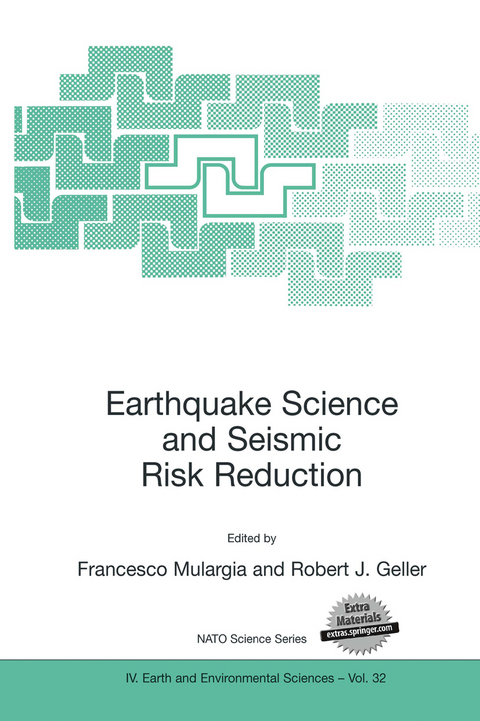
Earthquake Science and Seismic Risk Reduction
Springer-Verlag New York Inc.
978-1-4020-1778-0 (ISBN)
What is the first thing that ordinary people, for whom journalists are the proxy, ask when they meet a seismologist? It is certainly nothing technical like "What was the stress drop of the last earthquake in the Imperial Valley?" It is a sim ple question, which nevertheless summarizes the real demands that society has for seismology. This question is "Can you predict earthquakes?" Regrettably, notwithstanding the feeling of omnipotence induced by modem technology, the answer at present is the very opposite of "Yes, of course". The primary motivation for the question "Can you predict earthquakes?" is practical. No other natural phenomenon has the tremendous destructive power of a large earthquake, a power which is rivaled only by a large scale war. An earth quake in a highly industrialized region is capable of adversely affecting the econ omy of the whole world for several years. But another motivation is cognitive. The aim of science is 'understanding' nature, and one of the best ways to show that we understand a phenomenon is the ability to make accurate predictions.
1 Modeling earthquakes.- 1.1 Phenomenology.- 1.3 Model building.- 1.4 Prediction.- 1.5 References.- 2 The classical view of earthquakes.- 2.1 A geologist’s view of earthquakes.- 2.2 Seismology and geodesy.- 2.3 Scaling laws for earthquakes.- 2.4 The elastic rebound model and its successors.- 2.5 Nucleation or not?.- 2.6 What is an earthquake? Fracture, slip or both?.- 2.7 Stress: the basic yet unknown quantity.- 2.8 Earthquake energy balance.- 2.9 References.- 3 The Physics of complex systems: appHcations to earthquake.- 3.1 Phase transitions, criticality, and self-similarity.- 3.2 Scale invariance: the analytical approach.- 3.3 Scale invariance: the geometrical approach.- 3.4 Characterizing scale-invariant systems.- 3.5 Modeling scale invariant systems.- 3.6 The origin of power laws and fractality.- 3.7 Problems in applying CA models to earthquakes.- 3.8 Dynamical implications.- 3.9 Statistical implications.- 3.10 Implications for predictability.- 3.11 References.- 4 Time-independenthazard.- 4.1 Seismic Hazard assessment and site effects evaluation at regional scale.- 4.2 USGS and partners: approaches to estimating earthquake probabilities.- 4.3 References.- 5 Time-dependent hazard estimates and forecasts, and their uncertainties.- 5.1 USGS and partners: research on earthquake probabilities.- 5.2 Probabilistic forecasting of seismicity.- 5.3 What is the chance of an earthquake?.- 5.4 References.- 6 Gathering new data.- 6.1 Space geodesy.- 6.2 Paleoseismic data.- 6.3 References.- 7 Seismic risk mitigation.- 7.1 Greek case study.- 7.2 Istanbul case study.- 7.3 References.- 8 Earthquake prediction and public policy.- 8.1 Introduction.- 8.2 Views of social scientists.- 8.3 U.S. earthquake prediction program.- 8.4 Japan’s earthquake prediction program.- 8.5 Pubhc reactions to predictions.- 8.6 Discussion and conclusion.- 8.7 References.- Acknowledgments.- Addresses of principal contributors.
| Reihe/Serie | Nato Science Series: IV: Earth and Environmental Sciences ; 32 |
|---|---|
| Zusatzinfo | XVIII, 338 p. With CD-ROM. |
| Verlagsort | New York, NY |
| Sprache | englisch |
| Maße | 160 x 240 mm |
| Themenwelt | Mathematik / Informatik ► Informatik ► Theorie / Studium |
| Naturwissenschaften ► Geowissenschaften ► Geologie | |
| Naturwissenschaften ► Geowissenschaften ► Geophysik | |
| Naturwissenschaften ► Physik / Astronomie ► Mechanik | |
| Naturwissenschaften ► Physik / Astronomie ► Thermodynamik | |
| ISBN-10 | 1-4020-1778-2 / 1402017782 |
| ISBN-13 | 978-1-4020-1778-0 / 9781402017780 |
| Zustand | Neuware |
| Haben Sie eine Frage zum Produkt? |